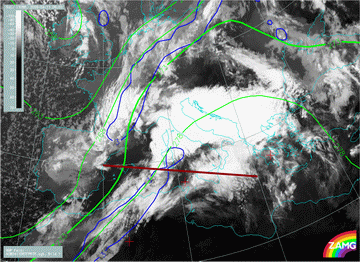Meteorological Physical Background
Generally Thickness Ridge Cloudiness is situated within a rising warm conveyor belt and is generally found within a ridge or a closed maximum of equivalent thickness.
Relative streams provide a good explanation of the physical processes of Thickness Ridge Cloudiness formation:
- A rising warm conveyor belt is associated with the Thickness Ridge Cloudiness;
- An upper relative stream/dry intrusion can be seen to the rear of the frontal cloud band;
- The warm conveyor belt dominates the Thickness Ridge Cloudiness over a thick layer and sometimes influences a part of the frontal cloud band (Drier upper relative streams are far behind the Thickness Ridge Cloudiness and usually not involved in the physics of the cloud itself).
|
|
11 April 2008/06.00 UTC IR - Meteosat 9 IR10.8 image; blue: thermal front parameter, green: equivalent thickness 500/850 hPa,
position of vertical cross section indicated
|
The above image shows Thickness Ridge Cloudiness over the Mediteranean Sea. The position of the front is indicated by the Thermal Front Parameter. The line of the vertical cross section is superimposed.
|
11 April 2008/06.00 UTC - ECMWF Vertical cross section; black: isentropes (ThetaE)
|
|
A maximum of ThetaE is observed in the area of the Thickness Ridge Cloudiness. This maximum is an indication of a tongue of warm air. It consists of a maximum of closed isolines in the lower layers indicating unstable conditions. These unstable conditions only exist in the area just above the ThetaE maximum. Bellow this maximum the atmosphere is conditionally stable because of the increase of ThetaE with height.The height of the maximum differs according to the seasons.
|
20 June 2000/06.00 UTC - Meteosat IR image, blue: thermal front parameter 500/850 hPa, green: equivalent thickness 500/850 hPa,
position of vertical cross section indicated
|
20 June 2000/06.00 UTC - Vertical cross section; black: isentropes (ThetaE), orange thin: IR pixel values, orange thick: WV pixel
values
|
The left image above shows the Thickness Ridge Cloudiness over the Baltic Sea. The position of the Thickness Ridge Cloudiness within the thickness ridge and the frontal system is indicated by the TFP. The line of the cross section is superimposed. The selection of the isentropic surfaces from the vertical cross sections was made following an analysis of the vertical distribution of the isentropes. The surfaces of 318K and 324K represent the relative streams within and above the superadiabatic stratification.
|
20 June 2000/06.00 UTC - Meteosat IR image; magenta: relative streams 318K - system velocity: 284° 8 m/s, yellow: isobars 318K,
position of vertical cross section indicated
|
20 June 2000/06.00 UTC - Meteosat IR image; magenta: relative streams 324K - system velocity: 284° 8 m/s, yellow: isobars 324K,
position of vertical cross section indicated
|
In both of the above images the distribution of relative streams shows a dominating rising warm conveyor belt at all levels. In the left image the warm conveyor belt at the 318K isentropic surface can be observed, rising from about 500 hPa up to about 450 hPa over the area of Thickness Ridge Cloudiness. In the higher isentropic surfaces of 324K the warm conveyor belt continues to rise from 400 hPa to about 350 hPa.
The tongue of warm air transported in the warm conveyor belt is also indicated by distinct warm temperature advection and a maximum in the
ridge of equivalent potential temperature.
The rising warm conveyor belt stream causes condensation.
The embedded convective cloudiness is a bit of a contradiction.
The Thickness Ridge Cloudiness is mostly consisting of fibrous cloudiness and is seldom associated with precipitation.
During the summer season there can be strong convective activity within the thickness ridge (compare
Convective cloud features in typical synoptic environments - The warm sector
). Furthermore, because of the thermal energy and the high relative humidity within the thickness ridge this convective activity can be very
strong.






